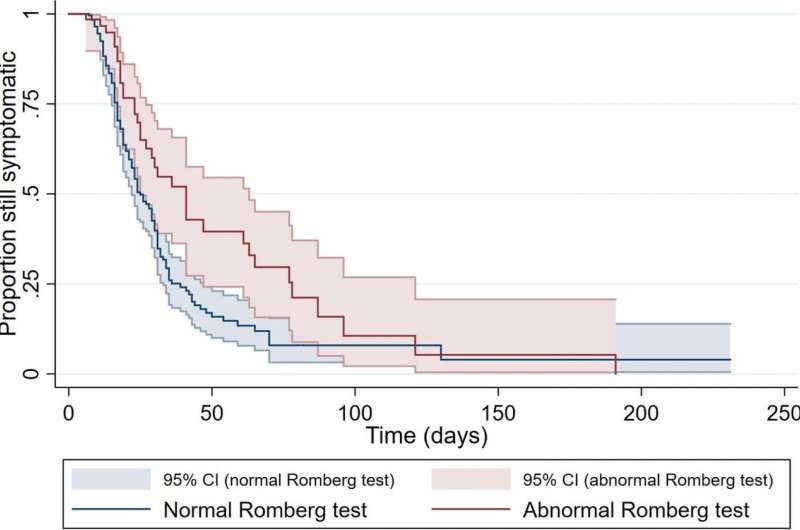Kaplan-Meier curve for duration of symptoms, grouped by those patients who displayed normal and abnormal performanceon the Romberg test when assessed within 10 days after injury. Shaded areas represent 95% confidence intervals (CIs). Credit: 2019 AANS.
Researchers from Children's Hospital Colorado and the University of Colorado School of Medicine in Aurora, Colorado, have found that abnormal performance on the Romberg balance test can indicate that children and adolescents will experience prolonged symptoms following sports-related concussion. This finding is reported today in a new article by David R. Howell, Ph.D., and colleagues in the Journal of Neurosurgery: Pediatrics ("Clinical predictors of symptom resolution for children and adolescents with sport-related concussion").
Concussion is a mild form of traumatic brain injury. In most cases, symptoms of concussion (headaches, dizziness, confusion, loss of memory, and others) subside within four weeks after injury. In some cases, however, symptoms do not resolve for months. Early recognition of predictors of lengthy recovery periods can help clinicians refer these patients for special therapies that may aid in the healing process.
Howell and colleagues set out to identify which variables assessed by sports medicine physicians during an initial evaluation of concussion in children or adolescents are independently associated with the length of time until symptom resolution.
The authors hypothesized that these variables would include the mental health condition of the patient before injury, history of previous concussion, and frequency of concussion-related symptoms within the first 10 days after the injury.
A wide range of variables were evaluated during the initial clinical evaluation: patient age and sex; previous diagnosis of concussion; sport engaged in at the time of concussion; history of ADHD, learning disability, migraine, or depression; frequency of concussion-related symptoms (patient responses to the Health and Behavior Inventory questionnaire, which covers 20 concussion-related symptoms); and balance as well as vestibular and ocular function (based on patient performance on the Balance Error Scoring System, Romberg, tandem gait, gaze stability, and near point of convergence tests).
To assess these variables, the authors obtained data from the case files of 351 children and adolescents (33% female, mean age 14.6 years) who sustained a sports-related concussion. All patients had been evaluated by a sports medicine physician within 10 days after injury. In most cases, patients were followed up until they no longer experienced concussion symptoms. The median duration of symptoms was 23 days.
The authors used statistical analyses to discover relationships between the variables and symptom duration.
Using univariate Cox proportional hazards models, the authors found that self-reported headache severity, headache frequency, confusion, forgetfulness, attention difficulties, memory difficulties, getting tired often, getting tired easily, and dizziness, as well as abnormal performance on the Romberg balance test, were each associated with a longer duration of symptoms following a concussion.
Using a multivariate Cox proportional hazards model, the authors found abnormal performance on the Romberg test to be the only variable evaluated that was independently associated with a longer duration of symptoms. Time until symptom resolution was significantly longer in patients who displayed abnormal performance on the Romberg test.
After adjustments had been made for patient age and sex, pre-injury mental health condition, and history of concussion, sensitivity multivariate analysis also showed an independent association between abnormal performance on the Romberg test and longer symptom duration following concussion.
The Romberg test is used to determine neurological function as it relates to balance. During the Romberg test, the patient is asked to stand with feet together and eyes closed. A normal performance on the Romberg test is defined as the ability to maintain balance with minimal movement. Abnormal performance is defined as loss of balance or exaggerated movement of the body.
The authors note that abnormal performance on the Romberg test may represent neurological injury leading to postural instability or it may represent exaggeration or feigning of symptoms. In both cases, the authors believe that additional therapy (referral to a physical therapist or mental health provider) should be offered to the patient.
When asked about the findings of the study, Dr. Howell said, "Our results provide further evidence for the importance of including some type of balance assessment in the evaluation of adolescents with a concussion. Specifically, we were interested to find that balance assessments may provide a tool for clinicians to use in concussion prognosis."
More information: Howell DR, Potter MN, Kirkwood MW, Wilson PE, Provance AJ, and Wilson JC: Clinical predictors of symptom resolution for children and adolescents with sport-related concussion. Journal of Neurosurgery: Pediatrics, published online, ahead of print, April 16, 2019; DOI: 10.3171/2018.11.PEDS18626 , thejns.org/doi/full/10.3171/2018.11.PEDS18626
Journal information: Journal of Neurosurgery: Pediatrics
Provided by Journal of Neurosurgery Publishing Group























